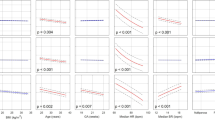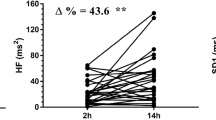Abstract
Objective
The aim of this study was to demonstrate the temporal profile of changes in heart rate variability (HRV), blood pressure variability (BPV), and cardiac baroreflex sensitivity (BRS) during the course of a healthy pregnancy.
Materials and methods
This was a longitudinal study during which autonomic variability parameters (HRV, BPV, BRS) were assessed in 66 pregnant women at 11–13, 20–22 and 30–32 weeks of gestation. A lead II electrocardiogram tracing and beat-to-beat blood pressure were recorded with the subject breathing spontaneously in the supine position. Changes in the parameters were analyzed using repeated measures analysis of variance.
Results
Overall HRV (SDNN; standard deviation of all NN intervals) was found to decrease significantly over the course of pregnancy (p < 0.05). Similarly, indices which represent the parasympathetic component of these variables (SDSD [standard deviation of differences between adjacent NN intervals]; pNN50 [NN50 count {number of pairs of adjacent NN intervals differing by more than 50 ms} divided by the total number of all NN intervals]; high-frequency [HF] power) were also found to decrease significantly from the first to third trimester of pregnancy (p < 0.05). Low-frequency (LF) power increased over the course of pregnancy (p < 0.05). The LF/HF ratio increased significantly from first to third trimester of pregnancy (median: 0.66 [first trimester] vs.1.02 [second] vs. 0.91 [third]; p < 0.05) Overall BPV increased during the course of pregnancy, with a significant rise in the HF component of BPV and a significant fall in the LF component of BPV with advancing gestation (p < 0.05). BRS decreased over the course of pregnancy (median: 16.31, interquartile range [IQR] 11.04–23.13 [first trimester] vs. 11.42, IQR 8.54–19.52 [second] vs. 8.84, IQR 7.15–12.45 [third] ms/mmHg; p < 0.05).
Conclusion
Pregnancy is associated with decreased vagal and increased sympathetic modulation of cardiac autonomic tone with advancing gestation, together with increased BPV. The reduction in cardiac BRS may play a role in increasing BPV and decreasing HRV over the course of pregnancy.

Similar content being viewed by others
References
Usselman CW, Skow RJ, Matenchuk BA, Chari RS, Julian CG, Stickland MK et al (2015) Sympathetic baroreflex gain in normotensive pregnant women. J Appl Physiol 119(5):468–474
Fu Q, Levine B (2009) Autonomic circulatory control during pregnancy in humans. Semin Reprod Med 27(04):330–337
Szymanska M, Bomba-Opon DA, Wielgos M (2008) Blood pressure and lipid changes in gestational diabetes mellitus. Neuro Endocrinol Lett 29(3):328–333
Task Force of the European Society of Cardiology and the North American Society of Pacing and Electrophysiology (1996) Heart rate variability: standards of measurement, physiological interpretation and clinical use. Circulation 93(5):1043–1065
Di Rienzo M, Parati G, Radaelli A, Castiglioni P (2009) Baroreflex contribution to blood pressure and heart rate oscillations: time scales, time-variant characteristics and nonlinearities. Philos Trans R Soc Math Phys Eng Sci 367(1892):1301–1318
Tsuji H, Larson MG, Venditti FJ, Manders ES, Evans JC, Feldman CL et al (1996) Impact of reduced heart rate variability on risk for cardiac events. The Framingham Heart Study. Circulation 94(11):2850–2855
Zuanetti G, Neilson JM, Latini R, Santoro E, Maggioni AP, Ewing DJ (1996) Prognostic significance of heart rate variability in post-myocardial infarction patients in the fibrinolytic era. The GISSI-2 results. GruppoItaliano per lo Studio dellaSopravvivenzanell’ InfartoMiocardico. Circulation 94(3):432–436
Parati G, Ochoa JE, Lombardi C, Bilo G (2013) Assessment and management of blood-pressure variability. Nat Rev Cardiol 10(3):143–155
La Rovere MT, Pinna GD, Maestri R, Sleight P (2013) Clinical value of baroreflex sensitivity. Neth Heart J 21(2):61–63
Walther T, Wessel N, Baumert M, Stepan H, Voss A, Faber R (2005) Longitudinal analysis of heart rate variability in chronic hypertensive pregnancy. Hypertens Res 28(2):113–118
Ramírez Ávila GM, Gapelyuk A, Marwan N, Stepan H, Kurths J, Walther T et al (2013) Classifying healthy women and preeclamptic patients from cardiovascular data using recurrence and complex network methods. Auton Neurosci 178(1–2):103–110
Eneroth E, Storck N (1998) Preeclampsia and maternal heart rate variability. Gynecol Obstet Invest 45(3):170–173
Kolovetsiou-Kreiner V, Moertl MG, Papousek I, Schmid-Zalaudek K, Lang U, Schlembach D et al (2018) Maternal cardiovascular and endothelial function from first trimester to postpartum. PLoS ONE 13(5):e0197748
Balajewicz-Nowak M, Furgala A, Pitynski K, Thor P, Huras H, Rytlewski K (2016) The dynamics of autonomic nervous system activity and hemodynamic changes in pregnant women. Neuro Endocrinol Lett 37(1):70–77
Moertl MG, Ulrich D, Pickel KI, Klaritsch P, Schaffer M, Flotzinger D et al (2009) Changes in haemodynamic and autonomous nervous system parameters measured non-invasively throughout normal pregnancy. Eur J Obstet Gynecol Reprod Biol 144:S179–S183
Voss A, Malberg H, Schumann A, Wessel N, Walther T, Stepan H et al (2000) Baroreflex sensitivity, heart rate, and blood pressure variability in normal pregnancy. Am J Hypertens 13(11):1218–1225
Baumert M, Javorka M, Seeck A, Faber R, Sanders P, Voss A (2012) Multiscale entropy and detrended fluctuation analysis of QT interval and heart rate variability during normal pregnancy. Comput Biol Med 42(3):347–352
D’Silva LA, Davies RE, Emery SJ, Lewis MJ (2014) Influence of somatic state on cardiovascular measurements in pregnancy. Physiol Meas 35(1):15–29
Walther T, Voss A, Baumert M, Truebner S, Till H, Stepan H et al (2014) Cardiovascular variability before and after delivery: recovery from arterial stiffness in women with preeclampsia 4 days post partum. Hypertens Pregnancy 33(1):1–14
Bertinieri G, di Rienzo M, Cavallazzi A, Ferrari AU, Pedotti A, Mancia G (1985) A new approach to analysis of the arterial baroreflex. J Hypertens 3(3):S79–81
Pagani M, Somers V, Furlan R, Dell’Orto S, Conway J, Baselli G et al (1979) Changes in autonomic regulation induced by physical training in mild hypertension. Hypertension 12(6):600–610
Kuo CD, Chen GY, Yang MJ, Lo HM, Tsai YS (2000) Biphasic changes in autonomic nervous activity during pregnancy. Br J Anaesth 84(3):323–329
Blake MJ, Martin A, Manktelow BN, Armstrong C, Halligan AW, Panerai RB et al (2000) Changes in baroreceptor sensitivity for heart rate during normotensive pregnancy and the puerperium. Clin Sci (Lond) 98:259–268
Matsuo H, Inoue K, Hapsari ED, Kitano K, Shiotani H (2007) Change of autonomic nervous activity during pregnancy and its modulation of labor assessed by spectral heart rate variability analysis. Clin Exp Obstet Gynecol 34(2):73–79
Carpenter RE, Emery SJ, Uzun O, Rassi D, Lewis MJ (2017) Influence of physical exercise on baroreceptor sensitivity during pregnancy. J Matern Fetal Neonatal Med 30(5):514–519
Montano N, Lombardi F, GnecchiRuscone T, Contini M, Finocchiaro ML, Baselli G et al (1992) Spectral analysis of sympathetic discharge, R–R interval and systolic arterial pressure in decerebrate cats. J Auton Nerv Syst 40(1):21–31
Visontai Z, Lenard Z, Studinger P, Rigo J, Kollai M (2002) Impaired baroreflex function during pregnancy is associated with stiffening of the carotid artery: baroreflex sensitivity and carotid distensibility in pregnancy. Ultrasound Obstet Gynecol 20(4):364–369
Lucini D, Strappazzon P, Vecchia LD, Maggioni C, Pagani M (1999) Cardiac autonomic adjustments to normal human pregnancy: insight from spectral analysis of R–R interval and systolic arterial pressure variability. J Hypertens 17:1899–1904
Easterling TR, Schmucker BC, Benedetti TJ (1988) The hemodynamic effects of orthostatic stress during pregnancy. Obstet Gynecol 72:550–552
Brooks VL, Mulvaney JM, Azar AS, Zhao D, Goldman RK (2010) Pregnancy impairs baroreflex control of heart rate in rats: role of insulin sensitivity. Am J Physiol Regul Integr Comp Physiol 298(2):R419–R426
Author information
Authors and Affiliations
Corresponding author
Ethics declarations
Conflict of interest
On behalf of all authors, the corresponding author states that there is no conflict of interest.
Rights and permissions
About this article
Cite this article
Garg, P., Yadav, K., Jaryal, A.K. et al. Sequential analysis of heart rate variability, blood pressure variability and baroreflex sensitivity in healthy pregnancy. Clin Auton Res 30, 433–439 (2020). https://doi.org/10.1007/s10286-020-00667-4
Received:
Accepted:
Published:
Issue Date:
DOI: https://doi.org/10.1007/s10286-020-00667-4




